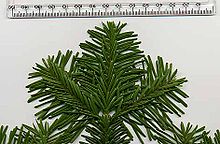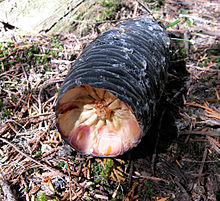Purple fir
| Purple fir | ||||||||||||
|---|---|---|---|---|---|---|---|---|---|---|---|---|

Purple fir ( Abies amabilis ) in the Salmon Mountains |
||||||||||||
| Systematics | ||||||||||||
|
||||||||||||
| Scientific name | ||||||||||||
| Abies amabilis | ||||||||||||
| ( Dougl. Ex Loudon) J. Forbes |
The purple-fir ( Abies amabilis ) is a plant from the genus of fir ( Abies ) in the family of Pinaceae (Pinaceae). They can be found along the west coast of Canada and the United States. The specific epithet "amabilis" means something like "lovely".
description
Appearance
The purple fir is an evergreen tree that can grow to heights of 25, in extreme cases up to 70 meters, and diameters from 60 to 260 centimeters at chest height . Young trees have a pointed crown that flattens out with age. The short and stiff branches go horizontally from the straight trunk and are usually opposite each other.
The smooth bark of young trees is light gray in color and usually has resin bubbles. In older trees, the bark breaks up into plates and turns reddish gray. The hairy bark of the twigs is light brown on the top and dark brown on the underside.
The seedlings form four to seven cotyledons ( cotyledons ) from.
Root system
While the seedlings still have a taproot , mature trees usually have a flat, extensive root system. If the bottom is covered by pyroclastic sediments , adventitious roots can form. As Mykorrhizapartner usually occurs Cenococcum graniforme on.
Buds and needles
The spherical buds, 6 to 9 millimeters in diameter, are brown in color and can be covered by a purple layer of resin.
The needles notched at the tip are between 0.7 and 4 inches long and 1 to 3 millimeters wide. They are glossy green on the top of the needle and silvery white on the underside. On the underside of the needle there are 5 to 6 rows of stomata on either side of the midrib . The needles are tightly packed in two rows on the branches and often overlap.
Flowers, cones and seeds
The purple fir is single-sexed ( monoecious ) and becomes manable at 20 to 30 years . During the pollen flight , which, depending on the location, extends from mid-May to mid-June, the male cones are colored red. They later turn reddish yellow. The upright, oval-cylindrical cones are between 8 and 18 centimeters long and 3.5 to 7 centimeters thick. They are initially purple-gray, and when ripe in late August they are brown in color. They have no stem and are resinous.
The light brown seeds are 10 to 12 millimeters long and around 4 millimeters wide. They have a reddish to light brown wing that is about the same length as the seed.
Chromosome number
The number of chromosomes is 2n = 24.
Distribution and location
The natural range of the purple fir extends from southeastern Alaska and western British Columbia in the north over western Washington and Oregon to northwestern California in the south. It populates both sides of the Cascade Range as well as parts of the Coast Mountains , the Olympic Mountains and the Klamath Mountains .
The purple fir can be found, depending on its location, from sea level to the tree line at an altitude of around 2300 meters. It is a tree species of the maritime climate . The species is often found in deep, well-drained and moist soils. The annual rainfall is between 965 and 6650 mm, depending on the location. The purple fir is considered to be one of the most shade-tolerant conifers and survives even decades of extreme shade.
ecology
In its natural location, the purple fir forms both pure and mixed stands. Pure stands are found primarily in the areas around Mount Baker and Mount Rainier, as well as in other areas of the Cascade Range in southern Washington. Mixed stands with the West American hemlock ( Tsuga heterophylla ) are formed in the entire distribution area . In southern Washington and northern Oregon, the noble fir ( Abies procera ) is also common. In the coastal areas west of the cascade range, the purple fir is associated with the sitka spruce ( Picea sitchensis ), the coastal pine ( Pinus contorta ), the Douglas fir ( Pseudotsuga menziesii ) and the giant arborvitae ( Thuja plicata ). The rocky mountain fir ( Abies lasiocarpa ), the mountain hemlock ( Tsuga mertensiana ) and the Nootka cypress ( Xanthocyparis nootkatensis ) are also common in subalpine locations . In the eastern edge areas of the natural range, the species also socializes with the West American larch ( Larix occidentalis ), the Engelmann spruce ( Picea engelmannii ) and the western Weymouth pine ( Pinus monticola ). In Northwest California there is also the formation of the magnificent fir ( Abies magnifica ).
The shrub layer in the entire distribution area is largely formed by the hedgehog plantain ( Oplopanax horridus ), Vaccinium membranaceum and Vaccinium ovalifolium . Elliottia pyroliflora , Menziesia ferruginea , Rhododendron albiflorum and Vaccinium deliciosum also occur at higher altitudes . The annoying Oregon grape ( Mahonia nervosa ) and the Shallon shamberry ( Gaultheria shallon ) are mainly found in lower elevations of the distribution area.
In the herb layer , the rib fern ( Blechnum spicant ), Clintonia uniflora , the Canadian dogwood ( Cornus canadensis ), the moss bell ( Linnaea borealis ), Rubus lasiococcus , Rubus pedatus and bear grass ( Xerophyllum tenax ) predominate.
use
The light, soft and brittle wood is mainly used as construction wood , plywood and for pulp production. It is also suitable as a veneer, as a sub-floor covering and as a panel. The purple fir is only occasionally used as a Christmas tree. Sometimes it is planted as a park or ornamental tree.
Diseases and pests
Abiotic harmful factors
The purple fir is affected to a large extent by abiotic damaging factors. Due to the shallow root system and thin bark, the species is susceptible to forest fires. Because of the shallow root system, it is at risk of wind throws. Wind breaks can also occur in closed stands during strong storms. The branches can break even with light snow loads.
Harmful fungi
A large number of harmful fungi occur on the purple fir. An infestation with the root sponge ( Heterobasidion annosum ) often occurs , whereby an infection can occur all year round. In its natural range, the species is considered to be one of the most susceptible trees to the common Hallimasch ( Armillaria mellea ) and Phellinus weiri , which both attack the roots. Old trees are prone to core rot , which is caused by Echinodontium tinctorium and Haematostereum sanguinolentum . While the two species do not occur in young populations, the risk of infestation increases with age. The needles are mainly attacked by Lophodermium uncinatum , Phaeocryptopus nudus , Virgella robusta and various species of the genus Uredinopsis . Felled trees rot very quickly and are mainly from Fichtenporling ( Fomitopsis pinicola ), the surfaces Lackporling ( Ganoderma applanatum ) Hirschioporus abietinus and Poria subacida affected. The total volume of the lying trunks decreases between 50 and 100 percent within 5 years.
Vegetable pests
The purple fir is a secondary host for Arceuthobium tsugense . It occurs in mixed stands with hemlocks . Arceuthobium abietinum infestation occurs primarily in central Oregon.
Animal pests
The purple fir is attacked by a large number of insect pests. The most important role is played by the pine stem louse ( Adelges piceae ) introduced from Europe , which attacks trees of all ages. If the crown is infested, shoot deformations, needle losses and reduced growth occur over several years. An infestation on the trunk can lead to the death of the tree. The pine stem louse is common in low-lying locations, while it rarely occurs in subalpine locations.
The most important cone pests include the hymenoptera Earomyia abietum , Megastigmus pinus and Megastigmus lasiocarpae , which can cause large seed losses. The two butterfly species Acleris gloverana and Lambdina fiscellaria occur mainly in mixed populations in British Columbia and cause unpinning. The needle pests of little importance include the serrated cortex tensioner ( Ectropis crepuscularia ) and Melanolophia imitata . Choristoneura freemani occurs in both pure and mixed stands. The two beetle species Pseudohylesinus granulatus and Pseudohylesinus sericeus can cause great damage if they occur together with root-damaging fungi.
The browsing by elk ( Cervus canadensis ) can reach large proportions. Chickens and rodents feed on the buds, while squirrels gnaw on the cones to get at the seeds. Occasionally trees are debarked by bears.
Systematics
Abies amabilis is assigned to the Amabiles section within the genus of firs ( Abies ) . It was first described in 1838 as Picea amabilis by John Claudius Loudon in "Arboretum et fruticetum Britannicum", Volume 4: Page 2342, a name he ascribed to David Douglas . It was placed in the genus Abies by James Forbes in his work "Pinetum Woburnense", p. 125, plate 44. Synonyms for Abies amabilis (Douglas ex Loudon) J.Forbes include Abies grandis Hook. non Lindl. or Pinus amabilis (Dougl. ex Loudon) Parl.
Despite the large distribution area, there are hardly any intraspecific differences between individual populations.
Hazard and protection
The species is listed as "not endangered" in the IUCN Red List . It is pointed out, however, that a new check of the risk is necessary.
swell
- Christopher J. Earle: Abies amabilis. In: The Gymnosperm Database. Retrieved December 2, 2010 .
- Peggy D. Crawford, Chadwick Dearing Oliver: Pacific Silver Fir. In: Silvics of North America, Vol. 1: Conifers. www.na.fs.fed.us, accessed December 18, 2010 (English).
- Abies amabilis in the endangered Red List species the IUCN 2010. Posted by: Conifer Specialist Group, 1998. Retrieved on December 2 of 2010.
Individual evidence
- ↑ a b c d e f g h i j Christopher J. Earle: Abies amabilis. In: The Gymnosperm Database. Retrieved December 2, 2010 .
- ↑ a b c d e f g h i j k l m n o p q Peggy D. Crawford, Chadwick Dearing Oliver: Pacific Silver Fir. In: Silvics of North America, Vol. 1: Conifers. www.na.fs.fed.us, accessed December 18, 2010 (English).
- ^ Tropicos. [1]
- ↑ Abies amabilis in the endangered Red List species the IUCN 2010. Posted by: Conifer Specialist Group, 1998. Retrieved on December 2 of 2010.



